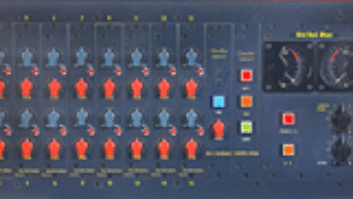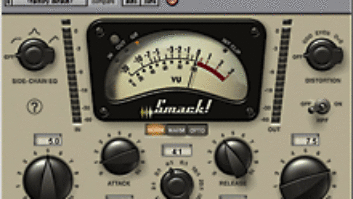With its “future-primitive” style and sound, the Chandler Limited TG1 seems to be from another age — plucked from a time capsule. This stereo limiter/compressor is based on the EMI TG12413 plug-in limiter module, which was used in the early 1970s TG Series mixing desks and mastering consoles. Designed to replace tube gear used in EMI studios around the world since the 1950s, the TG Series was EMI’s first foray into transistorized equipment. EMI built the TG boards in Hayes, Middlesex, and first installed them at EMI’s Abbey Road Studios in 1968, in time to be used to record The Beatles’ final studio album, Abbey Road. Many other significant records in the early ’70s through 1983 were recorded on TG desks, including Pink Floyd’s Dark Side of the Moon and some of Paul McCartney’s early solo and Wings albums.
A ROCKIN’ TWO-SPACE BOX
Hand-made in the U.S., the Chandler Limited TG1 features an all-discrete Class-A/B analog circuit with balanced transformer inputs and outputs. Neve module mavens will appreciate the Marinair and St. Ives input and output transformers, which, like most of the TG1’s components, are made in England. Not designed for a clean and transparent sound, amplifier gain is controlled by changing the bias current and therefore a Zener diode’s impedance. This Zener limiter produces a smooth, pleasing and colorful distortion, circa 1968.
Powered externally by the half-rackspace PSU-1 power supply, the TG1 comes in a rugged two-space, nickel-plated steel box that looks like a giant Neve module case. Popping the TG1’s hood reveals handsome construction with a neat wire harness connecting hand-soldered Elma switches on the front panel to a single, large printed circuit board. With construction better than it has to be, you can take this unit anywhere without worry. One note: The loose-fitting top panel rattles when operating in the presence of loud low-frequency sounds.
COOL LOOK AND STYLE
My eye was immediately pulled to the left side of the TG1’s British RAF gray front panel, where two black Sifam meters are canted on their sides. These meters read gain reduction only, and the novel positioning is exactly like the original TG desk’s VU meters: The needles move in an arc vertically instead of horizontally. Keeping with this official militaristic look, all switches are slightly recessed in the front panel, and control knobs are fitted with old-fashion black British radio pointer knobs.
To the right of the on/off switch and VU meters are switches for mono/stereo linking and individual in/out switches for left and right channels. The in/out hard-wired bypass switches put a loud “kerchunk” in your mix when toggled, so wait for no sound when engaging the unit. All controls retain EMI’s original British nomenclature — starting with the Hold control. Hold (shorthand for threshold, because the original TG modules didn’t have room for the whole word) is an input level and threshold in one knob; it works just like the input control on a Universal Audio 1176LN. Next to Hold is Output, or makeup gain, a 21-position rotary switch whose center position is 0 dB and ranges ± 10 dB.
There are two operating modes for the TG: Comp (compress) and Limit. A two-position rotary switch changes modes and an internally fixed attack time setting. In Comp mode, the attack time is fixed at 47 ms, while in Limit mode, the attack time is a faster 8 ms. Comp and Limit modes each have their own set of release time choices selectable by a six-position rotary switch called Recovery. Release time choices in Limit mode are 0.05, 0.1, 0.25, 0.5, one and two seconds. Comp mode choices are 0.25, 0.5, 1.20, 2.5, five and 10 seconds. Compression ratio is fixed at 2:1 in both modes.
IN THE STUDIO
The TG is very easy to use and does not require precise setup: Simply select a mode and recovery time and turn up the Hold control to get a sound. For everyday compression duties, I chose the Comp mode. For subtle compression (1 to 3 dB), I found that the Hold control was touchy: All action began at the very bottom of the range. I was feeding full-level, 24-bit audio directly from a Pro Tools|HD’s 192 I/O. I got a better range of control by inserting the TG1 in a channel of the board (post-fader) or by reducing the level going to it. If you do this, there is plenty of makeup gain available with the Output knob, but you might notice more noise buildup.
COMP MODE
I liked the Comp mode for electric guitars, vocals and rock bass guitar. The sound is thick, warm and open-sounding with little high-frequency dulling during heavy compression. The 0.22% distortion (at full compression) works especially well on guitars. When hard-pressed, the TG1 has a “rubbery” or “squishy” sound character, and is the most tube-sounding transistor compressor I’ve ever heard.
Using the TG1 on stereo tracks works well (although I wouldn’t use it across a master mix), but you have to remember to set both recovery knobs the same. Stumbling upon this quirk, I sent the same mono guitar track to both channels and purposely dialed very different recovery time settings. I got a level animation effect when I panned the 2-channel outputs left and right. This effect is intensified if you put one of the channels in the Limit mode.
EXTREME LIMIT MODE
Limit is much more radical than Comp. In the past, I’ve tried to copy the Ringo drum sound on Abbey Road, but never could quite get there with the American gear I had. (Refer to the songs “Something,” “She Came In Through the Bathroom Window,” “Carry That Weight” and “The End.”) A Fairchild 670 or an old British Pye unit will do well, but the TG1 nails it: You can get that classic pumping/breathing sound just by winding up the Hold control. Recovery time settings are critical; positions 1 or 2 work best for most drum parts. If you listen to an old Beatles record, recovery from gain reduction is locked to tempo (more or less) so that cymbals and any room ambience swell up in between bass drum hits and/or backbeats. This trick always works best on live microphones when tracking and for more precision; I wish the TG1’s Recovery controls were variable pots.
On a pair of drum room mics, the TG1 excels by capturing every part of the room tone. If you’ve got a good-sounding room to record in, I would be hard-pressed not to use the TG1 on the room mics. This is a classic ambient drum sound that has worked so well in the past on slower-tempo rock songs. For vocals and pianos to sound immediately Beatles-esqe, I used Comp or Limit and a 1 to 3 Recovery setting for a “Lady Madonna” piano. Drastically limit vocals in a mix with Recovery set to 1, and you’ll achieve a certain presence that can’t be hidden by the track.
Not modernized or updated — on purpose — the charming Chandler Limited TG1 Limiter/Compressor adds a whole new quadrant to your sonic palette with many useful compression sounds and “way over the top” limiter effects that are not possible with pristine pro audio gear. As an homage to a bygone era, I like the unit for guitars, vocals and any percussion. The Chandler Limited TG1 sells for $4,000 MSRP. The PSU-1 power supply is $125 MSRP, includes +48-volt phantom power and will run up to any four Chandler Limited products.
Chandler Limited, 100 East Bremer Ave., Waverly, IA 50677; 319/352-2587; fax 319/352-3136; www.chandlerlimited.com.
Barry Rudolph is an L.A.-based recording engineer.Visit his Website atwww.barryrudolph.com.
CHANDLER LIMITED TG1 SPECS
Input Impedance: 300 ohms
Output impedance: 600 ohms
Maximum output level: +28 dBm
Noise: -75 dBm
Frequency response: 15 Hz to 20k Hz
Distortion: 0.22% with Hold control full up.







